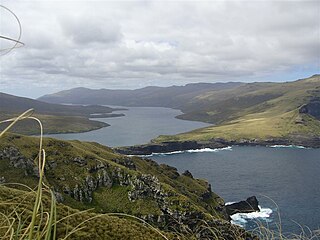
Auckland Island is the main island of the eponymous uninhabited archipelago in the Pacific Ocean. It is part of the New Zealand subantarctic area. It is inscribed in the UNESCO World Heritage list together with the other New Zealand Subantarctic Islands in the region.

The forest ringlet, also known as Helms' butterfly, or te pēpepe pōuri or pepe pouri in the Māori language, is a rare butterfly of the family Nymphalidae endemic to New Zealand. It is the only species in the genus Dodonidia.

Chionochloa is a genus of tussock grass in the family Poaceae, found primarily in New Zealand with one known species in New Guinea and another on Lord Howe Island. Some of the species are referred to as snowgrass.

Pleurophyllum speciosum, also known as the giant emperor daisy or Campbell Island daisy, is a megaherb native to the Auckland and Campbell Islands of New Zealand. A false colour image is depicted on the lower left corner on the reverse of the current five dollar New Zealand banknote. The Campbell Island daisy was first described by Joseph Dalton Hooker in Flora Antarctica of 1844, after he had collected it during the Ross expedition.

Poa foliosa is a species of tussock grass commonly known as muttonbird poa. It is native to the subantarctic islands of New Zealand and Australia.

Leptinella plumosa is a small flowering plant in the daisy family. It is a circumantarctic species found on many subantarctic islands in the Southern Ocean. The specific epithet comes from the Latin for “feathery”, referring to the form of the leaves.

Dracophyllum longifolium, commonly called inaka, is an upright shrub or small tree in the family Ericaceae that is endemic to New Zealand.

Deschampsia chapmanii is a plant species in the grass (Poaceae) family, native to New Zealand and Macquarie Island.

Anthoxanthum brunonis is a species of grass, native to the South Island of New Zealand and to the Auckland and Campbell Islands.

Proditrix chionochloae is a species of moth in the family Glyphipterigidae. It is endemic to New Zealand. It is classified as "At Risk, Declining'" by the Department of Conservation.

Carmichaelia astonii is a species of pea in the family Fabaceae. It is found only in South Island of New Zealand. Its conservation status (2018) is "Nationally vulnerable" under the New Zealand Threat Classification System.
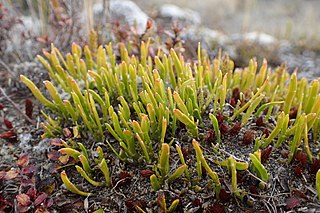
Carmichaelia nana is a species of plant in the family Fabaceae. It is found in both the North and South Islands of New Zealand. Its conservation status in 2013 was assessed as "At Risk (declinining)" under the New Zealand Threat Classification System, but in 2018 its risk under the same system became "Threatened-Nationally Vulnerable".

Tupeia is a monotypic genus of semi-parasitic shrubs (mistletoes) which occurs in both the North and South Islands of New Zealand. There is only one species in the genus: Tupeia antarctica. There are no synonyms.

Carex erebus is a member of the sedge family and is found on the Antarctic Islands of Australia and New Zealand.
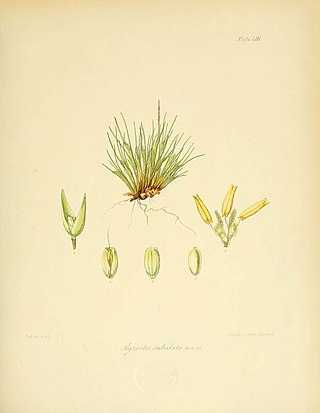
Agrostis subulata is a grass, which grows only on Campbell Island and on Antipodes Island in New Zealand.

Leptinella lanata is a small flowering plant in the daisy family, native to the Antipodean Islands. Its specific epithet, lanata, describes its woolly-haired (lanate) rhizomes.
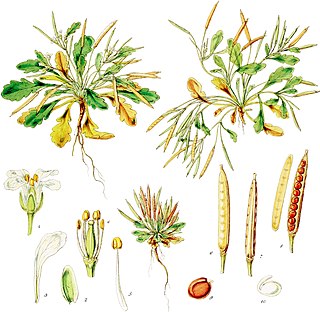
Cardamine depressa, commonly known as bitter cress, is a plant in the Brassicaceae family, found in the Antipodean Islands.
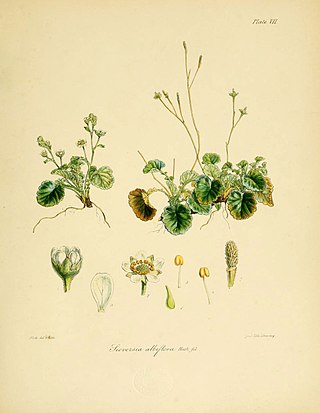
Geum albiflorum is a plant in the rose family, Rosaceae family, found in the Auckland Islands.

Actinotus novae-zelandiae is a plant in the Apiaceae family, native to the South Island of New Zealand.
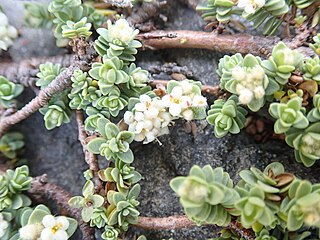
Pimelea urvilleana is a ground spreading shrub in the Thymelaeaceae family. There are two intraspecifics: Pimelea urvilleana subsp. nesica, and Pimelea urvilleana subsp. urvilleana.





















